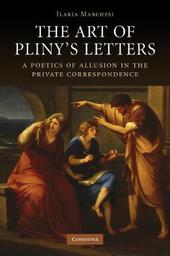
|
The Art of Pliny's Letters: A Poetics of Allusion in the Private Correspondence
Paperback / softback
Main Details
| Title |
The Art of Pliny's Letters: A Poetics of Allusion in the Private Correspondence
|
| Authors and Contributors |
By (author) Ilaria Marchesi
|
| Physical Properties |
| Format:Paperback / softback | | Pages:292 | | Dimensions(mm): Height 229,Width 152 |
|
| Category/Genre | Literary studies - classical, early and medieval |
|---|
| ISBN/Barcode |
9780521296977
|
| Classifications | Dewey:876.01 |
|---|
| Audience | | Professional & Vocational | |
|---|
| Illustrations |
Worked examples or Exercises
|
|
Publishing Details |
| Publisher |
Cambridge University Press
|
| Imprint |
Cambridge University Press
|
| Publication Date |
30 June 2011 |
| Publication Country |
United Kingdom
|
Description
In this book on intertextuality in Pliny the Younger, Professor Marchesi invites an alternative reading of Pliny's collection of private epistles: the letters are examined as the product of an authorial strategy controlling both the rhetorical fabric of individual units and their arrangement in the collection. By inserting recognisable fragments of canonical authors into his epistles, Pliny imports into the still fluid practice of letter-writing the principles of composition and organisation that for his contemporaries characterised other writings as literature. Allusions become the occasion for a metapoetic dialogue, especially with the collection's privileged addressee, Tacitus. An active participant in the cultural politics of his time, Pliny entrusts to the letters his views on poetry, oratory and historiography. In defining a model of epistolography alternative to Cicero's and complementing those of Horace, Ovid and Seneca, he also successfully carves a niche for his work in the Roman literary canon.
ReviewsReview of the hardback: '... perhaps the most ambitious literary examination of Pliny's letters produced in the last eighty years ... Marchesi successfully exposes the complexity of Pliny's enterprise, giving a clear sense of its richness and its detailed interaction directly and through intermediaries with both the literature of his own time and that of canonical stature.' International Journal of the Classical Tradition
|